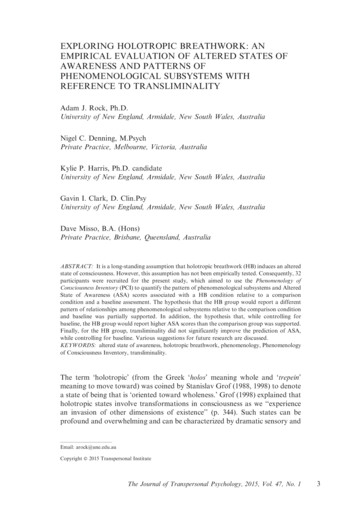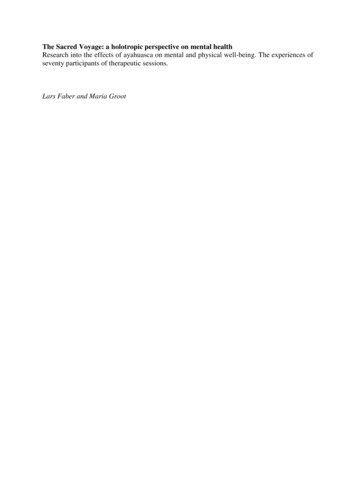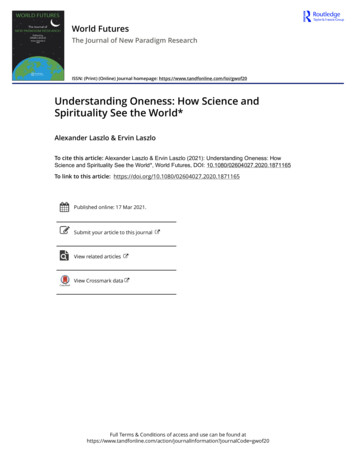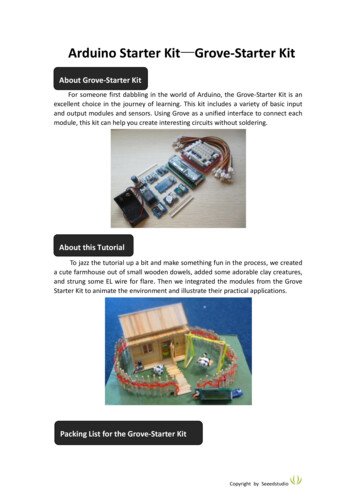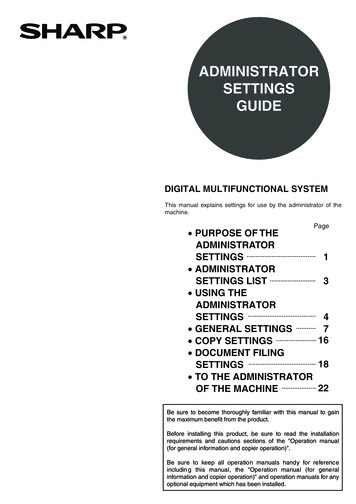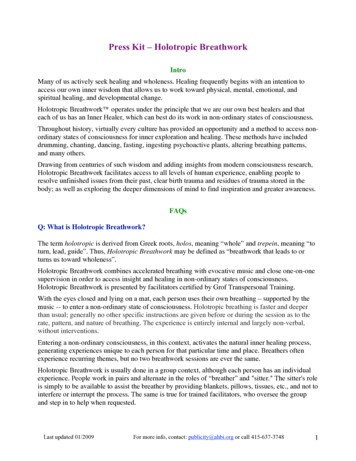
Transcription
Press Kit – Holotropic BreathworkIntroMany of us actively seek healing and wholeness. Healing frequently begins with an intention toaccess our own inner wisdom that allows us to work toward physical, mental, emotional, andspiritual healing, and developmental change.Holotropic Breathwork operates under the principle that we are our own best healers and thateach of us has an Inner Healer, which can best do its work in non-ordinary states of consciousness.Throughout history, virtually every culture has provided an opportunity and a method to access nonordinary states of consciousness for inner exploration and healing. These methods have includeddrumming, chanting, dancing, fasting, ingesting psychoactive plants, altering breathing patterns,and many others.Drawing from centuries of such wisdom and adding insights from modern consciousness research,Holotropic Breathwork facilitates access to all levels of human experience, enabling people toresolve unfinished issues from their past, clear birth trauma and residues of trauma stored in thebody; as well as exploring the deeper dimensions of mind to find inspiration and greater awareness.FAQsQ: What is Holotropic Breathwork?The term holotropic is derived from Greek roots, holos, meaning “whole” and trepein, meaning “toturn, lead, guide”. Thus, Holotropic Breathwork may be defined as “breathwork that leads to orturns us toward wholeness”.Holotropic Breathwork combines accelerated breathing with evocative music and close one-on-onesupervision in order to access insight and healing in non-ordinary states of consciousness.Holotropic Breathwork is presented by facilitators certified by Grof Transpersonal Training.With the eyes closed and lying on a mat, each person uses their own breathing – supported by themusic -- to enter a non-ordinary state of consciousness. Holotropic breathing is faster and deeperthan usual; generally no other specific instructions are given before or during the session as to therate, pattern, and nature of breathing. The experience is entirely internal and largely non-verbal,without interventions.Entering a non-ordinary consciousness, in this context, activates the natural inner healing process,generating experiences unique to each person for that particular time and place. Breathers oftenexperience recurring themes, but no two breathwork sessions are ever the same.Holotropic Breathwork is usually done in a group context, although each person has an individualexperience. People work in pairs and alternate in the roles of “breather” and "sitter." The sitter's roleis simply to be available to assist the breather by providing blankets, pillows, tissues, etc., and not tointerfere or interrupt the process. The same is true for trained facilitators, who oversee the groupand step in to help when requested.Last updated 01/2009For more info, contact: publicity@ahbi.org or call 415-637-37481
If requested by a breather, facilitators provide focused bodywork – or other forms of support – tohelp breathers relieve tension or complete the experience. After the session, participants givecreative expression to what happened through mandala drawing, and then are invited to tell theirexperiences to the group. These techniques help participants integrate the process.During the sharing and discussion sessions, the facilitator does not give interpretations of thematerial. The facilitator might simply ask the participant for further elaboration and clarification ,i.e. his or her insights from the session. Jungian amplification—in the form of mythological andanthropological references--can be very useful in understanding holotropic experiences andmandalas. On occasion, references to the facilitator’s own experiences in the past or experiences ofother people might be appropriate.Q: What are the origins of Holotropic Breathwork?Stanislav Grof, M.D. and his wife, Christina Grof, developed this powerful and natural technique inthe mid-1970's from modern consciousness research and their study of ancient spiritual systems.Dr. Grof is a psychiatrist with more than forty years of experience of research in psychotherapy andnon-ordinary states of consciousness. His early research was at the Psychiatric Research Institute inPrague, where he was Principal Investigator of a program systematically exploring the heuristic andtherapeutic potential of LSD and other psychedelic substances. Later, Dr. Grof conductedpsychedelic research as Assistant Professor at Johns Hopkins University and Chief of PsychiatricResearch at the Maryland Psychiatric Research Center. He also spent fourteen years as Scholar-inResidence at Esalen Institute in Big Sur, California.With the ban on the use of LSD for research purposes in the late 1960s, the Grofs developedHolotropic Breathwork as a powerful drug-free way to access non-ordinary states of consciousness.They began facilitating workshops in 1976 and offered their first structured training programs in1987. Together they have facilitated Holotropic Breathwork sessions for more than 25,000 peoplefrom 1987-1994. Stanislav Grof ’s many books, including Realms of the Human Unconscious(1975), Beyond the Brain (1985), Psychology of the Future (2002), and The Ultimate Journey(2006) have contributed to the steady rise of interest in the Holotropic Breathwork technique andtranspersonal psychology.Christina Grof is the author of The Thirst for Wholeness, and together the Grofs’ authored TheStormy Search for the Self, considered an indispensible guide for people experiencing psychospiritual crisis (“spiritual emergency”) and their friends, families and caregivers.Dr. Grof is one of the founders (with Abraham Maslow) and chief theoreticians of transpersonalpsychology, and he is the founding President of the International Transpersonal Association.Stanislav Grof and his staff in the Grof Transpersonal Training have trained almost a thousandcertified practitioners of Holotropic Breathwork, who are now practicing in many countries aroundthe world.Q: Why do people choose Holotropic Breathwork?Holotropic Breathwork is based on the assumption that we all have a mechanism that serves as aninner healer, a drive for pursuing wholeness, which can be accessed within a suitable context suchas Holotropic Breathwork provides. Anyone seeking healing for trauma, malaise, illness ordepression may benefit from the practice, as well as those seeking insight or guidance.Last updated 01/2009For more info, contact: publicity@ahbi.org or call 415-637-37482
Participants regularly report that HB has helped them to: a) relieve chronic pain, b) shiftdepression, c) release anger, d) improve medical conditions such as asthma, migraine, or premenstrual tension, e) support recovery from addiction, f) receive intuitive insights, and g) clarifytroublesome areas of their lives. In addition, participants report that it helped them find meaningand purpose in their life, get rid of negative thoughts, diminish their fear of death, releaseaccumulated stress and trauma, and a feel a sense of greater connection with physical, emotional,and spiritual parts of themselves.Q: What are the benefits of Holotropic Breathwork?In his book, Psychology of the Future, Stanislav Grof, co-founder of Holotropic Breathworkexplains, "in holotropic states, we can transcend the narrow boundaries of the body ego and reclaimour full identity." Holotropic Breathwork assists this process by inducing a non-ordinary state ofconsciousness in a safe context, enabling participants to reconnect with self, others, the naturalworld, and spirit.When the body and mind enter a non-ordinary state of consciousness through controlled breathing,in an appropriate context, the inner wisdom uses the opportunity to work toward physical, mental,emotional, and spiritual healing, and developmental change. Holotropic Breathwork operates underthe principle that we are our own best healers, in that each of us has an inner healing mechanism,which can best do its work in non-ordinary states of consciousness.Q: Who should practice Holotropic Breathwork?Anyone who wants to: access healing and insightexpand his or her consciousnesstap into more creativityrelease stress or anxietymove past stuckness and re-energize their liferelease emotional or physical symptoms and unproductive behavior patternstransform the negative side effects of long-forgotten events buried deep in their unconscious.heal traumaconnect more deeply or get in touch with their spiritual essencebe supported through a period of mourning or grievingexplore feelings about the state of the world around themwork through physical illness by exploring emotional issues associated with the illnessdiscover their higher calling or vocationexperience mystical statesmove on from depressionovercome feelings of discouragement, listlessness, or disorientationbecome empowereddeepen their capacity to support themselves and their loved onesaccess their inner wisdom and intuitionknow themselves more deeplycreate a more fulfilling lifeLast updated 01/2009For more info, contact: publicity@ahbi.org or call 415-637-37483
Q: How many people have tried Holotropic Breathwork?As of January 2009 there were 619 Facilitators trained and certified by Grof Transpersonal Trainingoffering workshops in 36 countries. AHBI estimates that, in the twenty years since the first traininggroup graduated in 1988, approximately 100,000 individuals have experienced HolotropicBreathwork. Internal research suggests participants, on average, return for an average of 10sessions each; thus at least one million Holotropic Breathwork sessions have taken place the pasttwo decades.Q: What research has been conducted in the arena of Holotropic Breathwork?Over 37 papers, by scholars and researchers in many countries, address and examine the healingpotential of HB; these include peer-reviewed articles, dissertations and scholarly papers.Thefollowing are conclusions reached by researchers in peer-reviewed journal research: In 1994, Spivak et al analysed the dynamics of brain evoked potentials concluding,“Consciousness alterations, occurring during HB, have not only phenomenal features butalso physiological correlates”.In 1995, Terekhin tested the external respiration function in HB during the course ofpsychotherapeutic treatment. In conclusion Terekhin states: “The results of the tests onexternal respiration during the HB(W) psychotherapeutic treatment confirm the nonordinary consciousness inducing mechanisms described in this work”.In 1996, Sarah Holmes et al investigated in a controlled study the relationship betweenthe use of HB and therapeutic changes in levels of distress associated with self-identifiedproblems, death anxiety, self esteem, and sense of affiliation with others. In conclusionHolmes states: “The HB group showed significant reductions in death anxiety andincreases in self esteem compared with the control group ” and “ results suggest thatexperiential approaches to psychotherapy may be useful in ameliorating some types ofpsychological problems.”In 2003 Binarova investigated the effect of a single or repeated Holotropic Breathworksession on certain personality properties, attitudes, and values orientations. Inconclusion, Binarova states: “Subjectively, all participants evaluated the experience fromthe Holotropic Breathwork session as contributing to better communication with people,to a deeper knowledge of the surrounding world, and to a higher acceptance ofpreviously rejected opinions and thoughts.”Additionally, multiple peer-reviewed journal articles and papers on the topic of HolotropicBreathwork have been published in recent years, including Rhinewine (2007), Robedee (2008).Visit the Research section of the AHBI website a www.ahbi.org to find out more.Q: What can I expect during a Holotropic Breathwork session?Holotropic Breathwork combines use of controlled breathing, music, and body work with anintention to heal. The process involves working in pairs where one person is in the role of“breather” and the other takes the role of "sitter". Sessions last for two to three hours. The sitter'srole is simply to be available to assist the breather, not to interfere or interrupt the process. Thesame is true for trained facilitators, who are available as helpers if necessary.Last updated 01/2009For more info, contact: publicity@ahbi.org or call 415-637-37484
Breathers lie down on mats on the floor while the sitter sits nearby. Participants are advised that it isbetter not to have a goal or specific agenda when beginning a breathwork, but rather to trust thatwhatever happens is the best outcome for healing. The facilitators lead a guided relaxation to helpthe breather relax the body in preparation for the breathing. The Holotropic Breathwork experienceis, for the most part, internal and largely nonverbal, without interventions. Although facilitatorssuggest to breathers, at the beginning of the session, that they increase the pace and depth of thebreath, breathers are also encouraged to find their own pace and rhythm. Thus, after the breathworksession begins, breathers are not "coached" in any particular way of breathing. The facilitators playevocative or rhythmic music as the breathing deepens.With the help of the breath, evocative music, a safe atmosphere, relaxation, and a willingness toembrace the experiences, breathers are guided by their own inner healing function to whateverexperience will bring them healing and transformation.The music continues for two to three hours. Sitters watch over their breather, providing a sense ofshelter and support. During the breathwork process, the breather can have quite a wide range ofpossible experiences. What is visible from the outside varies. Some people are very still whileothers rock, cry out, or move to the music. Experiences can include a variety of physical sensations,deep feelings of joy or serenity, “yogic sleep,” meditative states, or re-experiencing and releasingtrauma or traumas or the birth process. Some people report encounters with mythic or archetypalstorylines, past-life experiences, or direct spiritual or religious awakenings. Many see emotionallycharged visual images, feel energy moving through their bodies, receive intuitive insights, andclarify troublesome issues in their lives.Often participants report that they release accumulated stress, release emotions from old traumas,gain an increased trust in themselves and their bodies, and feel that they have understood and cannow transcend old patterns of behavior that have brought unwanted results.The experiences vary from individual to individual and from session to session. The sameindividual will often have different experiences each time he or she does Breathwork.At the end of the session, the facilitator checks in with the breather. If the breathwork has notresolved all of the emotional and physical tensions activated during the session, the facilitator mayoffer focused work to help release any stuck energy .Q: How should I prepare for a Holotropic Breathwork session?You might want to read an introductory book by Stanislav Grof, such as The Holotropic Mind orThe Adventure of Self-Discovery, to get a deeper understanding of the process. Get it touch with afacilitator near you, ask any questions you have, and make sure that you have a good feeling of trustwith that facilitator. (Many facilitators offer introductory talks that are open to the public.) Be surethat you have discussed, in advance, any possible medical contraindications. If you are currently intherapy, it is a good idea to talk about your intention to attend a Holotropic Breathwork workshopwith your therapist in advance.In the week prior to attending a workshop, you might find that you start to dream more vividly, feelmore emotional, or even some fear or anxiety about attending the workshop. This is all normal:your unconscious is aware that you are about to go on an adventure. Some of these feelings couldsimply be resistance to change, and others could be the “first edge” of the holotropic processmaking an appearance.Last updated 01/2009For more info, contact: publicity@ahbi.org or call 415-637-37485
Before attending a workshop, it is helpful to plan for your return to your regular environment.Returning to a pleasant, relaxed and loving environment, will allow you space and support tointegrate whatever has taken place in your psyche during the Breathwork session. In anticipation ofyour process, you may want to create a sacred space at home, arrange to stay with a sympatheticfriend, or at least alert your family that you will need some space.By all means, do not plan to attend a party or an important meeting – or any occasion at which youhave to ‘perform’ -- on the evening after your workshop. You will need some quiet time to be withyour thoughts and feelings. It’s also a good idea to arrange to have a day off, or at least a very lightschedule, for a day or two after the workshop. You might also want to schedule, in advance, afollow-up massage or other form of bodywork, which might help you integrate the experienceafterwards. Many people find that, for about a week following a workshop, they have heightenedsensitivities (emotional and physical), and an increased need for reflective time, so it is best to planfor this in advance.Q: What happens after a Breathwork session?When the breathwork session is complete, the breather is invited to paint or draw what happenedduring their session within the form of a circle, called a "mandala.” Those who wish to share whathappened in their Breathwork session, often using this mandala as a map or guide, are given theopportunity to do so in small groups. These groups provide a supportive and non-judgmentalenvironment in which the breather can begin to integrate her or his experience.Q: How can I integrate my experience after a Breathwork session?Exploration of images and insights received allows Breathwork participants to integrate them morefully and deeply into daily life. People do this in a variety of ways, including psychotherapy,bodywork, creative expression, dance, meditation, and prayer. It’s a good idea to keep yourmandala present and look at it, or contemplate it, often: it will keep teaching you. If you are feelingspacey or ungrounded after a workshop, it’s a good idea to use your body, do some gardening, andeat heavier food. Alternately, you may feel the need to de-tox: to eat lightly, meditate more, takelots of baths. If you have any concerns about how you feel or your state-of-mind after a workshop,please contact your facilitator to discuss this.Other modalities like direct body sensing, inquiry, naming, and allowing also help people learn totrust their own inner wisdom to guide their healing process.Q: How often should I do a Holotropic Breathwork session?There is no ‘right’ answer here. Some people have a life-changing experience in their very first HBsession, and feel no need for another session. Some people, if they are in an active or intensehealing process, might choose to do HB regularly – sometimes as often as once or twice per month,during this acute phase of their process. Many people feel that HB gives a boost to their regularform of therapy, so they will do a HB session perhaps every six months, or whenever they feelblocked, and then explore the insights from that session in the following months with theirtherapists. Other people consider HB to be their primary form of therapy, or might attend aworkshop every couple of months to relieve stress and maintain contact with their inner life. ManyHB participants find that it opens the door to a particular spiritual path, one that feels authentic toLast updated 01/2009For more info, contact: publicity@ahbi.org or call 415-637-37486
them, and they then stop doing HB to focus more on that spiritual path. Then again, for others, HBis their spiritual path.Q: What are the contraindications?Because this workshop can promote strong physical and emotional release, it is not advised forpersons with a history of cardiovascular disease, including angina or heart attack, high bloodpressure, glaucoma, retinal detachment, osteoporosis, significant recent physical injuries or surgery.This workshop is also not advised for persons with severe mental illness or seizure disorders or forpersons using major medications. It is also unsuitable for anyone with a personal or family historyof aneurisms. Pregnant women are advised against taking this workshop. Persons with asthmashould bring their inhaler and consult with the facilitators. Persons with infectious or communicablediseases are asked to avoid Holotropic Breathwork.This workshop is deeply experiential. It may involve intense and energetic emotional release. Theworkshop does not substitute for psychotherapy, but it can significantly deepen and enhancepsychotherapy and other healing and personal growth efforts.Q: How can I get more involved in Holotropic Breathwork?Start by participating in the AHBI online community, asking questions, and getting to know people.Or find a Holotropic Breathwork facilitator near you, go to an introductory talk, try a workshopor attend a training module – no experience is required. You can find facilitators, workshops, orupcoming in the Events section at www.ahbi.org. And by joining AHBI (Association for HolotropicBreathwork International) you will stay better informed about HB developments, and receive ourquarterly newsletter.Q: How can I train as a facilitator in Holotropic Breathwork?Certification in the GTT (Grof Transpersonal Training) requires about 600 hours of training thattakes at least two years to complete. This allows time for integration of the life-changing materialthat inevitably arises when people do breathwork over an extended period and provides acommunity context for support of rapid change.All of the training modules are six-day residential retreats. Some of them do not require anyprevious experience with Holotropic Breathwork (or an application to the training) and may betaken by anyone with an interest in Holotropic Breathwork. Each person can participate at their ownpace depending on their own process, available time, and financial considerations. Modules are heldat retreat centers in the United States and many other international locations.For those who wish to become certified, there are two tracks, Educational and Practitioner. Bothrequire attendance at seven modules (four on required topics and three optional), and a two-weekclosing intensive. In addition, the training includes ten hours of consultation with a certifiedpractitioner and an additional150 total hours (including those done before starting the training) ofparticipation in HB workshops led by Stan Grof or a certified practitioner. In addition, thosewishing to become independent workshop leaders (Practitioners), must apprentice at least fourtimes at workshops with previously certified practitioners before leading groups of their own.Practitioner certification is not guaranteed, but is at the discretion of Stan Grof and the trainingstaff. For more information on training as a facilitator, visit www.holotropic.com.Last updated 01/2009For more info, contact: publicity@ahbi.org or call 415-637-37487
FAQs About AHBI (The Association for Holotropic Breathwork International)Q: What is AHBI?The Association for Holotropic Breathwork International became an official non-profitmembership-operated organization in 1989. Incorporating officers, Cary Sparks, Kylea Taylor, andLaurie Weaver held the first meeting on April 8, 1990, and together with Stanislav and ChristinaGrof present, developed a statement of purpose. Laurie Weaver was elected as the first AHBIPresident and Kylea Taylor remained the acting editor of the publication, The Inner Door until 2007when she retired from AHBI.Q: Who are the Advisory Board members of AHBI?Current Advisory Board members include:Stanislav Grof, MD, PhD, co-creator of Holotropic Breathwork and one of the founders and chieftheoreticians of transpersonal psychology;Christina Grof, author, teacher, artist, psychotherapist, founder of the Spiritual EmergenceNetwork, and co-creator of Holotropic Breathwork;Jack Kornfield, PhD, founding teacher of the Insight Meditation Society and Spirit Rock andauthor of multiple books including A Path with Heart;Richard Tarnas, PhD, professor at the California Institute of Integral Studies, and author of ThePassion of the Western Mind and Cosmos and Psyche, winner of the Book of the Year Prize fromthe Scientific and Medical Network in England;Chris Bache, PhD, award-winning professor, Director of Transformative Learning at the Instituteof Noetic Sciences, and author of Lifecycles and Dark Night, Early Dawn; andKylea Taylor, M.S., M.F.T., one of the three initial incorporators of AHBI, who served as Editorof the newsletter and member of the Exeutive Committee until 2006. She is the author of TheBreathwork Experience, The Holotropic Breathwork Workshop Manual, and is the editor of theAHBI anthology, Exploring Holotropic Breathwork, among others.Q: What is the mission of AHBI?The mission of the Association for Holotropic Breathwork International is to support the practice ofHolotropic Breathwork as a resource for healing and transformation.AHBI does this by:1) Striving to make Holotropic Breathwork available to all who might benefit from it,2) Supporting the practice of Holotropic Breathwork facilitators and participants,3) Enabling connections and communications among all who are interested in HolotropicBreathwork,4) Promoting awareness about Holotropic Breathwork by distributing information andresearch in a variety of languages and formats, and5) Supporting research into the theory, practice, and effects of Holotropic Breathwork.Last updated 01/2009For more info, contact: publicity@ahbi.org or call 415-637-37488
You can support the publishing of HB research and research projects by becoming a member ofAHBI or donating to AHBI. Contact AHBI or find out more at www.ahbi.org.AHBI provides an extensive online community web site where interested parties can gainunderstanding about Holotropic Breathwork, communicate with practitioners and trainedfacilitators, find Breathwork workshops, and discover additional reading materials and resources.Q: Who can join AHBI (The Association for Holotropic Breathwork International)?Membership in AHBI is open to anyone who cares about Holotropic Breathwork for a set annualmembership cost, part or all of which may be tax-deductible for U.S. residents working in a relatedfield.Q: What is the Cost for Membership in AHBI (The Association for Holotropic BreathworkInternational)?AHBI Membership is just 65 per year (or 35 for those on low incomes or from developingcountries).Q: What are the benefits of joining AHBI (The Association for Holotropic BreathworkInternational)?AHBI members have a unique opportunity to directly support the practice of HolotropicBreathwork, research into Holotropic Breathwork, and to help make it available to ever-greaterrange of people who seek insight, healing, and improvement in their everyday lives. AHBI membersreceive a quarterly publication, The Inner Door -- the only regular publication exploring issues ofinterest to those on the holotropic journey. They also enjoy free access to an online archive of InnerDoor articles. Certified facilitators also receive a free searchable listing on the AHBI web site.Q: How can I contact AHBI or find out more?Visit the web site and online community at www.ahbi.org(Special thanks to Stan Grof, Kylea Taylor, Ted Riskin, Martin Boroson, Ken Sloan, Lenny Gibson,Oliver Williams and GTT (Grof Transpersonal Training) for their generous contribution to this vastcollection of information!)Last updated 01/2009For more info, contact: publicity@ahbi.org or call 415-637-37489
Examples of Experiences from Holotropic Breathwork One participant experienced a healing conversation with her father who had passed awaysuddenly a year before.Another found himself running through a jungle pursued by shadowy figures and wasprompted to seek to understand challenges he was running away from in ordinary life inorder to turn and face them.One woman felt herself contained in a box, unable to escape until she was given a creativesolution during the breathwork. This provided a strong metaphor that carried into herwaking life and allowed her to find a creative solution for a place where she was “stuck”there as well.Quotes & TestimonialsHolotropic Breathwork is "among the deepest and most profoundly comprehensive work of thespirit being offered today." --Jack Kornfield, author of A Path With Heart“Over and over again, I’m impressed by the power of the breath and its ability to correct specifichealth problems and promote our general wellness.”—Andrew Weil, M.D., from Breathing: TheMaster Key to Self-Healing“Stanislav Grof is arguably the world’s greatest living psychologist. He is certainly a pioneer inevery sense of the word, and one of the most comprehensive psychological thinkers of our era.” –Ken Wilber, The Eye of the Spirit“For me personally, this almost metaphysical dimension of [Grof’s] teaching speaks to me andcontinues to captivate me” -- Vaclav Havel, writer, dramatist, and former President ofCzechoslovakia“I know of no work that so well incorporates the findings of Freud, Jung and Rank, adding freshinsights, which the methods of those psychotherapists could never have achieved. I do not doubtthat many others working in this field would find Dr. Grof s discoveries a basis for a whole newstrategy of research.”-- Joseph Campbell, author of The Hero with a Thousand Faces, The Masks ofGod“Grof's work is the most important contribution to personality theory in several decades.”Abraham Maslow, founder of Humanistic PsychologyLast updated 01/2009For more info, contact: publicity@ahbi.org or call 415-637-374810
Recommended ReadingThe Breathwor
Holotropic Breathwork facilitates access to all levels of human experience, enabling people to resolve unfinished issues from their past, clear birth trauma and residues of trauma stored in the body; as well as exploring the deeper dimensions of mind to find inspiration and greater awareness
